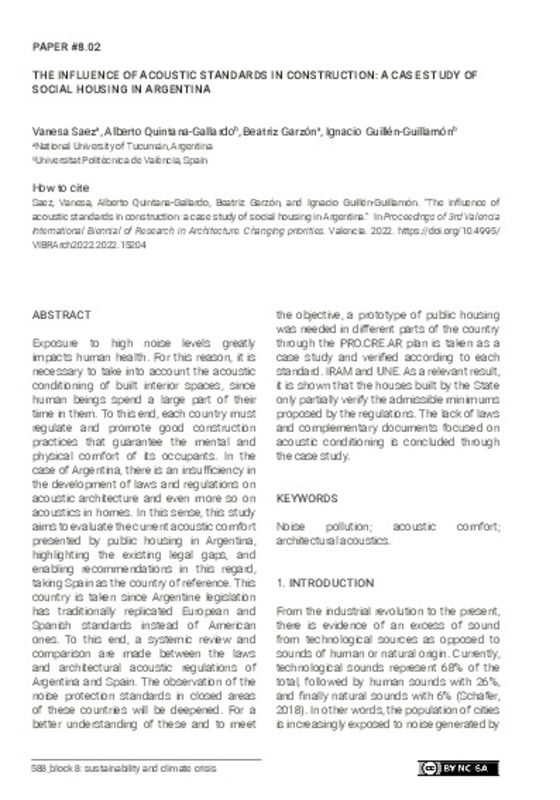JavaScript is disabled for your browser. Some features of this site may not work without it.
Buscar en RiuNet
Listar
Mi cuenta
Estadísticas
Ayuda RiuNet
Admin. UPV
The influence of acoustic standards in construction: a case study of social housing in Argentina
Mostrar el registro sencillo del ítem
Ficheros en el ítem
| dc.contributor.author | Saez, Vanesa
|
es_ES |
| dc.contributor.author | Quintana Gallardo, Alberto
|
es_ES |
| dc.contributor.author | Garzón, Beatriz
|
es_ES |
| dc.contributor.author | Guillén Guillamón, Ignacio Enrique
|
es_ES |
| dc.date.accessioned | 2023-12-21T10:53:53Z | |
| dc.date.available | 2023-12-21T10:53:53Z | |
| dc.date.issued | 2023-05-22 | |
| dc.identifier.isbn | 9788413960265 | |
| dc.identifier.uri | http://hdl.handle.net/10251/201007 | |
| dc.description.abstract | [EN] Exposure to high noise levels greatly impacts human health. For this reason, it is necessary to take into account the acoustic conditioning of built interior spaces, since human beings spend a large part of their time in them. To this end, each country must regulate and promote good construction practices that guarantee the mental and physical comfort of its occupants. In the case of Argentina, there is an insufficiency in the development of laws and regulations on acoustic architecture and even more so on acoustics in homes. In this sense, this study aims to evaluate the current acoustic comfort presented by public housing in Argentina, highlighting the existing legal gaps, and enabling recommendations in this regard, taking Spain as the country of reference. This country is taken since Argentine legislation has traditionally replicated European and Spanish standards instead of American ones. To this end, a systemic review and comparison are made between the laws and architectural acoustic regulations of Argentina and Spain. The observation of the noise protection standards in closed areas of these countries will be deepened. For a better understanding of these and to meet the objective, a prototype of public housing was needed in different parts of the country through the PRO.CRE.AR plan is taken as a case study and verified according to each standard. IRAM and UNE. As a relevant result, it is shown that the houses built by the State only partially verify the admissible minimums proposed by the regulations. The lack of laws and complementary documents focused on acoustic conditioning is concluded through the case study. | es_ES |
| dc.format.extent | 9 | es_ES |
| dc.language | Inglés | es_ES |
| dc.publisher | Editorial Universitat Politècnica de València | es_ES |
| dc.relation.ispartof | Proceedings - 3rd Valencia International Biennial of Research in Architecture, VIBRArch | |
| dc.rights | Reconocimiento - No comercial - Compartir igual (by-nc-sa) | es_ES |
| dc.subject | Noise pollution | es_ES |
| dc.subject | Acoustic comfort | es_ES |
| dc.subject | Architectural acoustics | es_ES |
| dc.title | The influence of acoustic standards in construction: a case study of social housing in Argentina | es_ES |
| dc.type | Capítulo de libro | es_ES |
| dc.type | Comunicación en congreso | es_ES |
| dc.identifier.doi | 10.4995/VIBRArch2022.2022.15204 | |
| dc.rights.accessRights | Abierto | es_ES |
| dc.contributor.affiliation | Universitat Politècnica de València. Departamento de Física Aplicada - Departament de Física Aplicada | es_ES |
| dc.contributor.affiliation | Universitat Politècnica de València. Centro de Tecnologías Físicas: Acústica, Materiales y Astrofísica - Centre de Tecnologies Físiques: Acústica, Materials i Astrofísica | es_ES |
| dc.contributor.affiliation | Universitat Politècnica de València. Escuela Técnica Superior de Arquitectura - Escola Tècnica Superior d'Arquitectura | es_ES |
| dc.description.bibliographicCitation | Saez, V.; Quintana Gallardo, A.; Garzón, B.; Guillén Guillamón, IE. (2023). The influence of acoustic standards in construction: a case study of social housing in Argentina. Editorial Universitat Politècnica de València. 588-596. https://doi.org/10.4995/VIBRArch2022.2022.15204 | es_ES |
| dc.description.accrualMethod | OCS | es_ES |
| dc.relation.conferencename | 3rd Valencia International Biennial of Research in Architecture, VIBRArch | es_ES |
| dc.relation.conferencedate | Noviembre 09-11, 2022 | es_ES |
| dc.relation.conferenceplace | Valencia, España | es_ES |
| dc.relation.publisherversion | http://ocs.editorial.upv.es/index.php/VIBRArch/VIBRArch2022/paper/view/15204 | es_ES |
| dc.description.upvformatpinicio | 588 | es_ES |
| dc.description.upvformatpfin | 596 | es_ES |
| dc.type.version | info:eu-repo/semantics/publishedVersion | es_ES |
| dc.relation.pasarela | OCS\15204 | es_ES |








